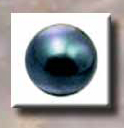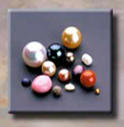

Pearl


Pearl is the official birthstone for the month of June as adopted by the American National Association of Jewelers in 1912. It is also the birthstone for the Sun Signs of Gemini and Cancer. Fresh water pearls are given on the 1st wedding anniversary. Pearls are also given on the 3rd, 12th and 30th anniversaries.
An organic gem, pearls are formed inside mollusks such as oysters and mussels. They are formed when an irritant such as a tiny stone or bit of sand gets inside the mollusk's shell. A lustrous substance, called nacre, is secreted around the object to protect the soft internal surface of the mollusk. As layer upon layer of nacre coats the irritant, a pearl is formed. Light that is reflected from these overlapping layers produces a characteristic iridescent luster. This process of building a solid pearl can take up to seven or eight years.
The most valuable pearls are perfectly symmetrical, large, naturally produced, and have a shimmering iridescence (called orient luster). The principal oyster beds lay in the Persian Gulf, along the coasts of India and Sri Lanka, and in the Red Sea. Chinese pearls come mainly from freshwater rivers and ponds, whereas Japanese pearls are found near the coast in salt water.
There are many types of
pearls:
Natural Pearls
(made with no
human interference),
Cultured Pearls
(made when a
human intentionally inserts foreign tissue into a living oyster),
Baroque Pearls
(irregularly-shaped pearls), freshwater pearls, seed pearls,
Biwa Pearls
(a freshwater pearl from
Lake Biwa, Japan),
Blister Pearls
(grown attached to the shell),
Black Pearls
(gray to black
pearls),
Mabe Pearls
(cultivated blister
pearls).
Pearls vary in color from white to those with a hint of color, often pink, to brown or black. Coloration depends on the type of mollusk and the water. Because the nacre is organic, pearls are very sensitive to acids, dryness, and humidity and care should be taken when storing them.
Pearls are quite "soft" and range between 2.5 and 4.5 on the Mohs scale of hardness. They should be protected from extreme wear.
Natural pearls have been harvested from the Persian Gulf, the Gulf of Manaar (Indian Ocean), and the Red Sea for thousands of years. The coasts of Polynesia and Australia produce mainly cultured pearls. Both freshwater and saltwater pearls are cultivated in Japan and China. Freshwater pearls occur in the rivers of Scotland, Ireland, France, Austria, Germany, and the USA
The Five most important factors that determine the Value of pearls are as follows:
Size
Pearl size is mostly determined by two factors: the size of the implanted nucleus and the thickness of the nacre that grows layer upon layer around the nucleus. A large cultured pearl that lacks nacre thickness has a low value, and tends to discolor and crack fairly easily. A pearl with a thick nacre coating will retain its luster and beauty for a lifetime when properly cared for. For pearls of similar quality, the most important other determinant of price is the size of the pearl. The size is generally measured in millimeters.
Shape
Perfectly round cultured pearls are the most rare. Although most cultured pearls are nearly round, only about 1% are perfectly spherical. To check a strand for roundness, roll it across a flat surface. The strand should move evenly and smoothly
Luster
Luster refers to the surface property that imbues cultured pearls with their shine and beauty. When checking pearls for luster, view them while standing with your back to a source of light. The sharper your reflection on the surface of the pearl, the higher is the luster and the better the quality.
Color
Pearls come in a variety of shades, with the major classifications being white, pink, silver, cream, gold, and black. Choice pearls also have a secondary color, or “overtone”, around the surface of the pearl. These overtones are usually rose, green or blue. The color should emanate from deep within the center of the pearl. All the pearls in a strand should be consistent in color.
Surface
Just as with any product of nature, all cultured pearls have minor imperfections. A quality cultured pearl is free of large pits or blemishes.
![]()
Email:Bruce@TapleyCollection.com
Copyright: 1979, The Tapley Collection
Copyright: 2005, www.TapleyCollection.com